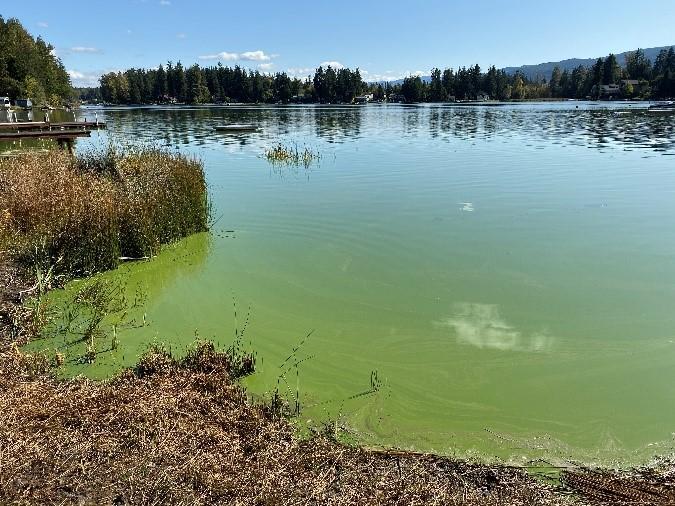How to Safely Enjoy Water Recreation in Thurston County
"How's the water?" is a question many people have before they go swimming, paddle-boarding, boating, fishing, or otherwise enjoying the many bodies of water in our area. Here are some tips from Thurston County Public Health and Social Services Water Quality Program to help assess water quality before you enjoy water activities.
Check ahead of time for advisories:
- Thurston County's [[[toxic algae (cynobacteria) advisories.]]]
- Sign-up to receive Thurston County's algae email alerts.
- State Department of Ecology's salt water swimming beach advisories.
- State Department of Health's Shellfish harvesting safety map.
- Washington State's freshwater algae bloom monitoring program.
Check the conditions once you arrive:
- Is there an algae bloom? Is the water cloudy with algae or is there a scum on the surface?
- If you visit a lake and notice a bright green color or scum along the shore, stay out of the water.
- Avoid swimming in areas where there are obvious algae blooms.
- While not all algae are harmful, some blue-green algae produce toxins that can cause illness in humans and kill pets, fish, and other animals. Unfortunately, the only way to know if toxins are present is to test. When in doubt, stay out!
- Are there high numbers of ducks or geese near the swimming area? Their waste (poop) in the water increases bacteria levels and can cause swimmer's itch.
- Is the beach crowded? Are there restrooms nearby? Is there a place to shower or rinse off before and after swimming?


(Harmful algae or cyanobacteria can look like foam, scum, paint, or mats on the surface of the water and can be different colors. Pictures taken at Lake Lawrence, October 2019, courtesy of Sarah Ashworth)
Play smart to reduce the risk of drowning
Learn basic swimming and water safety skills
Supervise closely
Wear a life jacket
Learn CPR
Know the risks of natural waters
Avoid alcohol
Use the buddy system
Take additional precautions for medical conditions
Consider the effects of medications
Don't hyperventilate or hold your breath for a long time
For more information:
https://www.cdc.gov/drowning/prevention/index.html
Play smart to reduce your risk from waterborne diseases:
- Keep the water out of your mouth.
- Toweling vigorously right after coming out of the water helps prevent swimmer's itch.
- Shower or rinse off as soon as possible after swimming or coming in contact with the water.
- Bring along soap and water for washing hands. Before enjoying your snack or picnic, be sure to wash your hands and ensure your children do too.
- Do not feed the ducks and geese. It is not healthy for them and leads to overcrowding, increased bacteria, and swimmer's itch.
- Stay out of the water if you have had diarrhea within the last 48 hours.
- Children or adults wearing diapers can wade, but should not immerse their lower bodies in the water
The Thurston County Public Health and Social Services Department's Water Quality Program conducts three types of monitoring on some of the local lakes.
- Long-term Trends: The program monitors for long-term trends in the availability of nutrients that cause algae blooms and overall water quality once a month from May through October at Black Lake, , Hicks Lake, Lake Lawrence, Long Lake, Offut Lake, Pattison Lake, Lake St. Clair, Summit Lake, and Clear Lake. The water quality reports are posted on the county's Water Monitoring Reports webpage.
- Summer Months: Each week during the summer months, the county also monitors swimming beaches at the Kenneydell County Park on Black Lake and Burfoot County Park on the Puget Sound. If the water is unsafe for swimming, the health department will post advisories.
- Toxic Algae: The program responds to calls or emails from lake residents or lake users who notify the county of a potential algae bloom. Once notified, health department staff investigate the bloom and take samples of the algae to be tested for toxins. Individuals signed up to receive the county's algae email alerts will be notified when a sample is collected, along with results and advisories if one is issued. If you see an algae bloom in one of our local lakes, please help by calling 360-867-2626 or emailing enhealth@co.thurston.wa.us.

(You may see this sign at different bodies of water. You can find additional toxic algae information at www.nwtoxicalgae.org)
What is a Lake Management District and how do they help address water quality issues?
A Thurston County water specialist works with local communities to protect the quality of water in Long Lake and Lake Lawrence. These activities are funded and managed through Lake Management Districts (LMDs), a form of special-service district that receives revenues through charges on lake-area properties. Improvement and maintenance projects created by LMDs have included aquatic plant control, comprehensive lake studies, development of long-term management plans, and watershed controls to protect drinking water supplies. Learn more about LMDs on the county’s Lake Management Districts webpage.
As the weather warms up, remember to check for advisories before you head out to enjoy the water. When you arrive at your destination, check the water conditions, and play smart to reduce your risk from waterborne diseases. If you have concerns about the water, please contact Thurston County Public Health and Social Services by calling 360-867-2626 or emailing enhealth@co.thurston.wa.us so the Water Quality Program team can assess the situation. Don’t forget to sign up for the algae email alerts and check out local advisories before you head out to enjoy the many different types of bodies of water in Thurston County and the Puget Sound!

(Summit Lake, courtesy of Sarah Ashworth)
Questions and inquiries regarding News Release content should be directed to the Thurston County Public Information Supervisor:
Meghan Porter
360-490-0562
